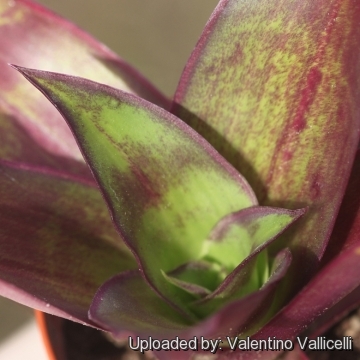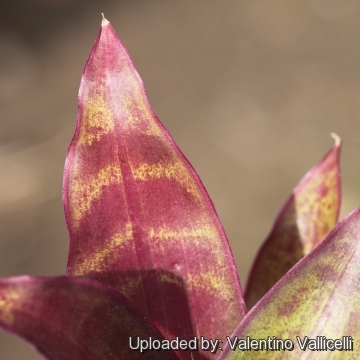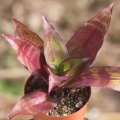
Tradescantia spathacea cv. Unknown Photo by: Valentino Vallicelli
Origin and Habitat: Garden origin (Nursery produced cultivar)
Synonyms:
See all synonyms of Tradescantia spathacea
back
Accepted name in llifle Database:Tradescantia spathacea Sw.Prodr. [O. P. Swartz] 57. 1788 [20 Jun-29 Jul 1788]Synonymy: 12
Cultivars
(1):
back
Description: Tradescantia spathaceaSN|25968]]SN|25968]] is a rather succulent small and low-growing plant, with rosettes of waxy lance-shaped leaves metallic green above, with glossy purple underneath. This plant is also known as Rhoeo discolorSN|25969]]SN|25971]] and more frequently in the horticulture trade as Rhoeo spathaceaSN|25971]]SN|25969]].
The unknown cultivar here descibed has distinguishing and very showy leaves which are banded with dark purple transversal zones in the upper face.
Habit: It is an erect perennial rosette-forming herb with fleshy rhizomes. Plants are invariably clump-forming, giving rise, in time, to large stands.
Stems: Short, reclining or erect, up to about 20 cm long.
Rosettes: It has rosettes of waxy lance-shaped leaves. They are very attractive foliage plants that will reach 1 foot (30 cm) tall.
Leaves: Sessile, dagger-shaped to strap-shaped, acuminate, scarcely narrowed above the sheath, somewhat fleshy, spirally arranged in stiff, upright rosettes, usually dark to metallic green above, with glossy purple or vivid violet underneath, 20-35 cm long by 3.5-5.5(-7.5) cm wide, hairless.
Inflorescences: Borne nestled in the leaf axils on a short stalk, 20-45 mm long. Bracts in pairs, long lasting, greenish-purple, deeply folded, boat shaped 20-45 mm long and 25-50 mm wide.
Flowers: Flowers numerous between the pairs of boat shaped bracts, scarcely projecting. 10-15(-20) mm in diameter. Tepals 3 white (or pinkish), elliptic. Petals 3, white. Stamens 6 with white filaments and yellow anthers. Sepals, petals and stamens free and approximatively equal. Ovary 3-celled with a single ovule per cell. Flower-stalks approx 15 mm long, recurved.
Blooming season: Flowering and seeding all year given the right conditions.
Subspecies, varieties, forms and cultivars of plants belonging to the Tradescantia spathacea group
- Tradescantia spathacea Sw.: has rather succulent rosettes of waxy lance-shaped leaves metallic green above, with glossy purple underneath. Distribution: Southern Mexico, Belize, Guatemala and naturalized elsewhere in the tropics.
 Tradescantia spathacea cv. Unknown: has distinguishing and very showy leaves which are banded with dark purple transversal zones in the upper face.
Tradescantia spathacea cv. Unknown: has distinguishing and very showy leaves which are banded with dark purple transversal zones in the upper face.
Bibliography: Major references and further lectures
1) David W. Nellis "Poisonous Plants and Animals of Florida and the Caribbean" Pineapple Press Inc, 1997
2) Robert B. Faden: "Commelinaceae in der Flora of North America," Volume 22, 2000
3) Deyuan Hong & Robert A. DeFilipps: "Commelinaceae in der Flora of China" Volume 24, 2000
4) Gordon Cheers (Hrsg.) "Botanica: Das ABC der Pflanzen. 10.000 Arten in Text und Bild" Könemann Verlagsgesellschaft, 2003
5) Balick, M. J., M. H. Nee & D.E. Atha. "Checklist of the vascular plants of Belize." Mem. New York Bot. Gard. 85: i–ix, 1–246. 2000
6) Berendsohn, W. G. & A. E. A. González. "Listado básico de la Flora Salvadorensis. Monocotelydoneae: Iridaceae, Commelinaceae, Gramineae, Cyperaceae." Cuscatlania 1(6): 1–29.1991.
7) Davidse, G., M. Sousa Sánchez & A.O. Chater. "Alismataceae a Cyperaceae." 6: i–xvi, 1–543. In G. Davidse, M. Sousa Sánchez & A.O. Chater (eds.) Fl. Mesoamer.. Universidad Nacional Autónoma de México, México, D. F. 1994
8) Hunt, D. R. 1994. 257. "Commelinaceae." 6: 157–173. In G. Davidse, M. Sousa Sánchez & A.O. Chater (eds.) Fl. Mesoamer.. Universidad Nacional Autónoma de México, México, D. F.
9) Jørgensen, P. M. & S. León-Yánez. (eds.) 1999. Cat. Vasc. Pl. Ecuador, Monogr. Syst. Bot. Miss. Bot. Gard. 75: i–viii, 1–1181. Missouri Botanical Garden, St. Louis.
10) Martínez Salas, E. M., M. Sousa Sánchez & C. H. Ramos Álvarez. 2001. "Región de Calakmul, Campeche. Listados Floríst..." México 22: 1–55.
11) Novelo, A. & L. Ramos. 2005. "Vegetación acuática." Cap. 5: 111–144. In Biodivers. Tabasco. CONABIO-UNAM, México.
12) Wunderlin, R. P. 1998. Guide Vasc. Pl. Florida i–x, 1–806. University Press of Florida, Gainseville.
13) Smith Prof. Gideon, Gideon Smith "Gardening with Succulents" Struik, 2005
14) M. D. Dassanayake "A Revised Handbook of the Flora of Ceylon", Volume 14 CRC Press, 01/giu/2000
15) Alfred Byrd Graf “Exotica [three] 3: Pictoral Cyclopedia of Exotic Plants” Roehrs, 1963
16) Alfred Byrd Graf “Tropica: Color Cyclopedia of Exotic Plants and Trees” Simon & Schuster, 01/giu/1978
 Tradescantia spathacea cv. Unknown Photo by: Valentino Vallicelli
Tradescantia spathacea cv. Unknown Photo by: Valentino Vallicelli Tradescantia spathacea cv. Unknown Photo by: Valentino Vallicelli
Tradescantia spathacea cv. Unknown Photo by: Valentino VallicelliCultivation and Propagation: Tradescantia spathaceaSN|25968]]SN|25968]] is a classic interiorscape plant also wideley cultivated in tropical gardens.
Soil: Although it likes soil with substantial organic matter, it will grow well in very porous sandy substrata or even in lava or coral rock that allow soil to dry slightly between waterings.
Repotting and transplantation: It transplants easily and broken pieces resprout readily.
Exposure: Bright light ro light shade, but it grows well in bright sun as well as in fairly dim light. Variegated forms benefit from some afternoon shade.
Waterings: It appreciates moist soil, but tolerates drought well.
Hardiness: It is a tropical plant, but it may survive a light freeze if covered and coddled. Hardy in USDA zones 9-12.
Garden uses: It is often planted as a ground cover or border plant, but also survives as an epiphyte on exposed rocks, logs and in the forks large trees.
Propagation: Stem cutting, division of larger clumps. New plants may be started from cuttings taken in the spring and rooted in light sandy soil or by potting up offsets. It is also possible to start plants from seed by crumbling an old blossom cluster and placing it on the soil.
Warning: The watery sap has an unidentified irritating chemical in it. The watery juice reddens the skin and provokes a stinging, itching, burning sensation. Gardeners often suffer a rash from extensive skin contact with the plant or its sap. Transient pain and irritation result from a droplet of the juice contacting the eye. Burning of the mouth and throat, stomach pain and intestinal irritation result from internal use. The best treatment is to remove the offending sap from the skin as soon as possible with soap and water, or with clean water if the sap is in the eye.
Your Photos

by Valentino Vallicelli














